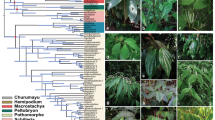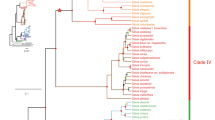Abstract
The chemosystematic potential of the 15 more common diterpene types in vascular plants was evaluated. Oxidation levels and skeletal specializations indicate diterpene biosynthesis to involve contrasting modes in pteridophytes and angiosperms on one hand, and in gymnosperms on the other. In angiosperm lineages diterpene diversification accompanies trends towards increase of herbaceousness and depletion of polyphenols, i.e., towards evolutionary advance. Nevertheless, even closely related families may display disjunctions of diterpene type and substitution. Thus the taxonomic value of this metabolic class remains confined to single (advanced) families.
Similar content being viewed by others
References
Borin, M. R. de M. B., Gottlieb, O. R., 1993: Steroids, taxonomic markers? — Pl. Syst. Evol.184: 41–76.
Bremer, K., 1987: Tribal interrelationships of theAsteraceae. — Cladistics3: 210–253.
Connolly, J. D., Hill, R. A., 1991: Dictionary of terpenoids,2. — London: Chapman & Hall.
Cronquist, A., 1988: The evolution and classification of flowering plants. — New York: The New York Botanical Garden.
Dev, S., 1985: CRC Handbook of terpenoids: Diterpenes,I. — Florida: CRC Press.
Gershenzon, J., Mabry, T. J., 1983: Secondary metabolites and the higher classification of angiosperms. — Nordic J. Bot.3: 5–34.
Gottlieb, O. R., 1982: Micromolecular evolution, systematics and ecology. — Berlin, Heidelberg, New York: Springer.
, 1989: The role of oxygen in phytochemical evolution towards diversity. — Phytochemistry28: 2545–2558.
, 1990: Phytochemicals: Differentiation and function. — Phytochemistry29: 1715–1724.
, 1990: A chemosystematic overview of pteridophytes and gymnosperms. — InKubitzki, K., (Ed.): The families and genera of vascular plants,I. — Berlin, Heidelberg, New York: Springer.
, 1993: The role of ellagitannins in the evolution of dicotyledons. — Taxon42: 539–552.
Harborne, J. B., Turner, B. L., 1984: Plant chemosystematics. — London: Academic Press.
Seaman, F., Bohlman, F., Zdero, C., Mabry, T. J., 1990: Diterpenes of flowering plants.Compositae (Asteraceae). — Berlin, Heidelberg, New York: Springer.
Sneath, P. H. A., Sokal, R. R., 1973: Numerical taxonomy. The principles and practice of numerical classification. — San Francisco: Freeman.
Webster, G. L., 1994: Synopsis of the genera and suprageneric taxa ofEuphorbiaceae. — Ann. Missouri Bot. Gard.81: 33–144.
Author information
Authors and Affiliations
Additional information
Part 36 in the series “Plant chemosystematics and phylogeny”. For Part 35 seeBorin & Gottlieb (1993). Based in part on the doctoral thesis presented byM. R. Figueiredo to Universidade de São Paulo in 1992.
Rights and permissions
About this article
Cite this article
Figueiredo, M.R., Kaplan, M.A.C. & Gottlieb, O.R. Diterpenes, taxonomic markers?. Pl Syst Evol 195, 149–158 (1995). https://doi.org/10.1007/BF00989291
Received:
Revised:
Accepted:
Issue Date:
DOI: https://doi.org/10.1007/BF00989291




